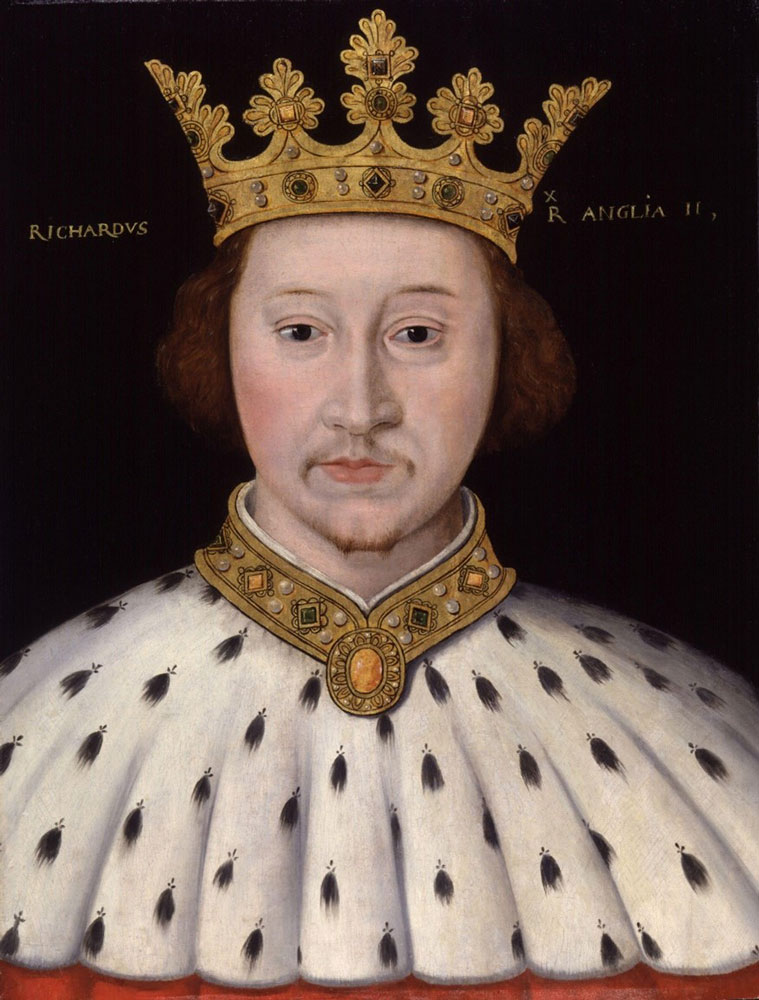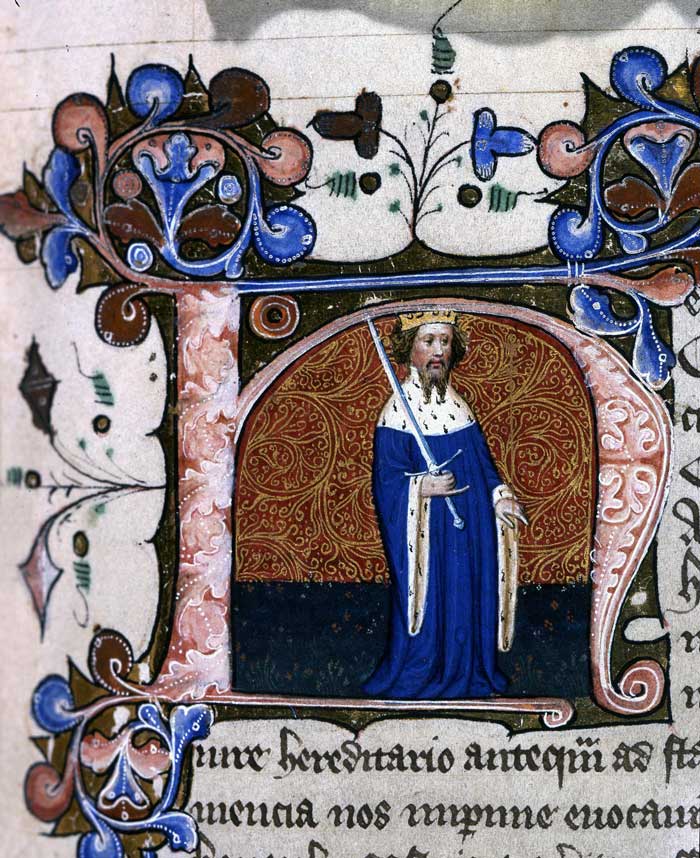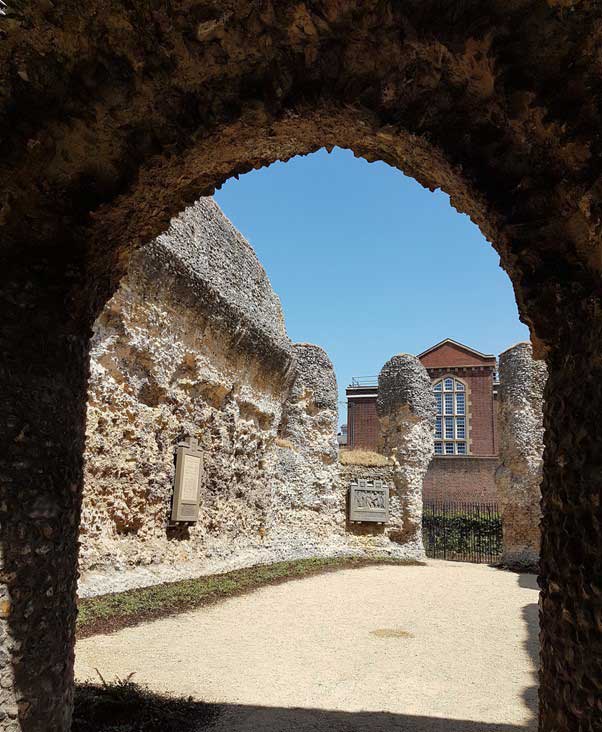The crime of high treason, as first defined in law in 1352 and still on the statute book today, was set out in five key clauses. Of these was a clause which we might consider to be the clearest form of treason, plots against the life of the monarch or leading members of the royal family.
‘When a Man doth compass or imagine the Death of our Lord the King, or of our Lady his Queen or of their eldest Son and Heir’
The first of the 1352 articles defined treason as ‘compassing or imagining’ the death of the king, his queen, or their eldest son (see footnote 1). The terms ‘compassing’ and ‘imagining’ are synonymous, and describe the action of plotting, planning or scheming. Treason here was defined not by the end result but by the intent to bring about the death of the monarch, and generally required an overt or open action – such as evidence of a physical attempt at assassination – upon which a traitor could be placed on trial (see footnote 2). Such a requirement, however, was not included in the text of the act itself, and within fifty years the definition of what it meant to ‘imagine’ a death would be stretched, almost to breaking point, in the law courts of England.
It is in the laws of Alfred the Great that we find the origins of this form of treason, where it was stated that plotting the death of the King was different from plotting the death of a lord, but what did it actually mean to ‘compass or imagine’? In a series of blogs the curators of our current exhibition – Treason: People, Power & Plot – will explore some of the ways that this clause has been interpreted over the last 700 years as seditious thoughts, words and writings were pulled into this Anglo-Norman French definition.

In part one of these blogs, we’ll be looking into instances where words, speech and writings might become treasonous.
Defining treason
The first judicial expansion in what might constitute ‘imagining’ was the problem of treasonous words, both spoken and written (see footnote 3). After the tumultuous final years of Richard II’s reign, which had seen definitions of treason expand wildly, the new king Henry IV was quick to revoke the actions of his predecessor and return treason to its 1352 confines. In his first parliament of 1399, Henry claimed that he wished to act differently to the recently deposed king in returning the treason to its original definition.
In reality this was not to be the case. The new Lancastrian regime immediately began to crack down on treasonous words, particularly statements that Richard II was still alive and would return to take back his throne. Such claims, in the context of Henry’s usurpation of the throne, were dangerous, providing a focus for discontent.

In 1402 at least five such cases involving treasonous words were recorded, four of which concerned the ‘false Richard’. These charges were not brought under new legislation, but through a form of judicial construction, intended to bring actions under the ‘compassing and imagining’ terminology of 1352.
Intent to incite
The first of these was a man named John Sperhauk, who was brought before the King’s Bench and charged with repeating words which had been spoken to him by a tailor’s wife in Baldock. She had complained to Sperhauk that the king was not lawful and that the Earl of March should be king by right. Furthermore she claimed that Henry IV was not the son of John of Gaunt but was actually the bastard son of a Ghent butcher, that the rebel Owain Glyn Dŵr was the true legal prince of Wales and Cornwall, and that the Pope had promised remission for all those supporting the earl and prince to secure what was rightfully theirs.

Some of these statements drew on rumours which had circulated in London in the 1370s, posted as written bills in prominent public places, but were now repeated as an oral complaint, which Sperhauk repeated to various individuals in Cambridgeshire (see footnote 4). In doing so, and in ‘affirming and avowing the said words as true’, Sperhauk was charged with the ‘intent’ to incite and arouse the king’s subjects against him.

In considering whether Sperhauk’s words consisted of an overt act in their own right, the royal justices appear to have been wary and consulted extensively with the council before proceeding, stressing the public nature of his words, his willingness to speak them of his own free will, his re-affirmation of the claims he has heard and his intent to incite the people to ‘depart from the love and good will owed to their liege lord’.
Sperhauk was found to be guilty, and suffered the full traitor’s death – drawing, hanging and quartering – the first of a series of cases in which treasonous words were targeted by the king and his justices.

On the record
In some cases, the actual words used by those condemned as traitors were themselves recorded in English in the records of the royal law courts. In 1413 John Wyghtlok found himself before the King’s Bench on charges of treason, having posted a series of anti-Lancastrian bills (similar to those which had inspired Sperhauk’s comments) around London. The bills, one of which was preserved as evidence in the court’s records, claimed that Richard II was still alive in Scotland in the care of the duke of Albany, a fact which Wyghtlok was willing to submit himself to prison to prove. With the caveat that he was not to be submitted to torture or mistreatment during his captivity, he claimed to be willing to submit himself to the ‘vilest death’ that could be chosen by the justices should his claim be found to be false.

Here, as with Sperhauk, his actions were deemed to have been done ‘traitorously’, inciting the people to withdraw their love from the king, and to subvert the realm: ‘compassing and imagining’ his death in the process.
Wyghtlok had, however, also committed a second form of treason, adhering to the king’s enemies the Scots, and had even brought a Scottish spy, Sir Andrew Lake, with him to London. Under the 1352 act, this was a clear instance of treason, and yet the obsession with his words is evident in the records of his trial, read out in the courtroom and preserved in the official record. His case was never heard by a jury, however. Wyghtlok escaped the Tower of London while awaiting a jury to be assembled, with the janitor who had aided him in his escape instead subjected to the traitor’s death in Wyghtlok’s place.
The burden of proof
The care with which charges of treasonous speech were framed and prosecuted are particularly clear in the case of a Reading gentleman, Thomas Kerver, in 1444 (see footnote 5). Kerver had been charged with complaining in the precinct of Reading Abbey to various servants of the abbot about the king, quoting the sermon ‘Woe to thee O land when thy king is a child’ and claiming that the realm would have been more than £100,000 better off had the king died 20 years earlier (shortly after he had taken the throne at the age of only 9 months).

The charges were framed under a series of articles: that he had compassed and imagined the death of the king; that he had attempted to encourage others to do the same; and each of his statements on the matter were recorded individually. Kerver was put on trial and found guilty on all charges except one – encouraging others to compass and imagine the king’s death, for which he was acquitted.
While he had been found guilty of his utterances, however, it was not certain that this would be enough to secure a judgement of high treason. Further proof of encouraging and inciting others to compass and imagine the king’s death was required. Rather than proceeding to judgement, Chief Justice Fortescue instead called a halt to proceedings, and instigated an entirely new investigation into Kerver’s actions – a rare example of re-investigation which highlights judicial concerns.
New charges were brought before a jury, in which the second article (on which he had been acquitted) was completely re-written, with other more minor changes added in order to try and secure a watertight conviction. While the substance of the accusation remained the same, the details differed, in order to remove any potential loopholes. This time Kerver was found guilty on all charges and condemned as a traitor.

Kerver was sentenced to be led through the streets of Reading and out to Maidenhead and Bray in a public display of shame, before being drawn to the nearest gallows and subjected to the full traitor’s death, but it was not to be. Due to the proximity of the feast of the Assumption, on which visitors to nearby Eton College received special papal indulgences, Kerver would be given a royal pardon by Henry VI, although the warrant for his pardon explicitly specified that he was not told his fate until the last possible minute.
The warrant states that he was to be drawn and hanged (until nearly dead) as usual, and only then informed about his pardon (which was otherwise to be kept secret). The very public warning about ‘compassing and imagining’ and treasonous words would remain, even if Thomas Kerver kept his life.
In the next of these blogs, we’ll be looking into treasonous magic, and the language of treason during dynastic conflicts.
You can find out more about the stories touched on in this blog in our exhibition Treason: People, Power & Plot, which runs until 6 April 2023, where you can view the following documents and many more:
- The 1352 Treason Act
- John Wyghtlok’s treasonous bill
You can also read more in our book, A History of Treason, available to purchase now from our online shop and all good booksellers.
Footnotes
- The 1352 Treason Act was most recently modified in 2015 by Succession to the Crown Act (2013), which made the provision for the eldest son gender neutral.
- The question of whether an overt act was required or not, has been much discussed over the centuries as a consequence of the failure to specify the need for an overt act in the 1352 treason act. Where the phrase is used in the statute, it refers only to adhering or giving aid or comfort to the king’s enemies. For more on this see J. Bellamy, The Law of Treason in England in the Later Middle Ages (Cambridge, 1970), p. 123
- C 65/62, m. 15, published in ‘Henry IV: October 1399’, in Parliament Rolls of Medieval England, ed. Chris Given-Wilson, Paul Brand, Seymour Phillips, Mark Ormrod, Geoffrey Martin, Anne Curry and Rosemary Horrox (Woodbridge, 2005): British History Online http://www.british-history.ac.uk/no-series/parliament-rolls-medieval/october-1399
- The question of whether there was a distinct form of treason by words which developed in the fifteenth century, in which the words themselves stood as treasonous, has been much debated by legal and political historians alike. What is clear, however, is the interest ascribed to treasonous or seditious statements as proof of an individual’s private compassing and imagining of the monarch’s death, evidence of their ‘evil heart’ and malicious intentions
- As Amanda McVitty has noted, it is interesting that only the words of the man appear to have been treated as treasonous, not those of the tailor’s wife. For more on the role of gender and masculinity in medieval treason cases see the excellent E. Amanda McVitty, Treason and Masculinity in Medieval England (The Boydell Press, 2020) [1] The legal nuances of Kerver’s trials and actions are best detailed in C.A.F. Meekings, ‘Thomas Kerver’s Case, 1444”, The English Historical Review (April, 1975)
Would Geoffrey Ridel (Riddell) who came to power after Thomas Beckett during King Henry II’s reign considered a traitor or conspirator toward Thomas Beckett even though he was more a religious leader than a King or was it just that Geoffrey had to do more penance and show remorse for his supposed role in the killing of Beckett?
Very interesting article, many thanks.
I once came across a case from Dartford in Kent in the KB9 Indictment rolls (KB9/541) which demonstates well your point about stretching the meaning of the word “imagine” to breaking point. Not sure if sentence was carried out.
Summary: Further to information given by Thomas Brok of Dertford, baker; Walter Symson, Richard Hosteler, Robert Newman, and John Miller, all of Dertford. That they were amicably sitting at an ale-house in Dartford, when Thomas Broke proposed a toast: “God save the King Henry, here ys good ale”. To which Robert Rumewyck of Dartford, miller, alias Robert Myller of Dartford, labourer, said, “God save the cuppe of good ale, for kyng Henry shall bee hanged when twenty other shalbe savyd”. Thomas Broke then asked, “Knowest what thow saiest”, to which he replied, “I saye as I sayd, God save the cuppe of good ale for kyng Henry shalbe hangyd, when twentye other shalbe savyd”. Robert charged with compassing the King’s death and taken into custody. He denies the charge. Jury finds him guilty, and that he has no goods nor chattels. Sentence: Robert to be taken by the sheriff to gaol, then to be taken along the highway to the gallows to be hanged. Further he is to be disembowelled and entrails burnt, head to be cut off and body to be quartered and placed where the king directs.